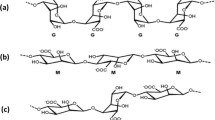Abstract
Microencapsulation processes may be divided into three steps, namely: incorporation of the bioactive substance in the matrix, dispersion of the matrix in droplets, and conversion in microcapsules. This contribution is focused on the second step and more specifically using the dripping approach to form droplets by extrusion of liquid through a nozzle. Different technologies of dripping are described, using as an example the production of alginate beads.
Access this chapter
Tax calculation will be finalised at checkout
Purchases are for personal use only
Similar content being viewed by others
References
Steele JAM, Hallé JP, Poncelet D, Neufeld RJ (2014) Therapeutic cell encapsulation techniques and applications for diabetes. Adv Drug Deliv Rev 67–68:74–83
Poncelet D, Tam S (2009) Microencapsulation technologies for bioartificial endoctrine pancreas. In: Hallé JP, de Vos P, Rosenberg L (eds) The bioartificial pancreas. Transworld Research Network, Kerala, India p. 37–49
De Vos P, Lazarjani HA, Poncelet D, Faas MM (2014) Polymers in cell encapsulation from an enveloped cell perspective. Adv Drug Deliv Rev 67–68:15–34
Lindblad NR, Schneider JM (1969) Production of uniform-sized liquid droplets. J Sci Instrum 42:635–639
Rhodes M. (2013) Single particles in a fluid. In: Introduction to Particle Technology (2nd Ed.). Chichester: Wiley; pp 30–51
Poncelet D, Neufeld RJ, Goosen MFA, Bugarski B, Babak V (1999) Formation of microgel beads by electric dispersion of polymer solutions. AIChE J 45(9):2018–2023
Rayleigh JWS (1878) On the instability of the jet. Proc Lond Math Soc 10:4
Prusse U, Dalluhn J, Breford J, Vorlop KD (2000) Production of spherical beads by Jet Cutting. Chem Eng Technol 23(12):1105–1110
Author information
Authors and Affiliations
Corresponding author
Editor information
Editors and Affiliations
Rights and permissions
Copyright information
© 2017 Springer Science+Business Media New York
About this protocol
Cite this protocol
Bidoret, A., Martins, E., De Smet, B.P., Poncelet, D. (2017). Cell Microencapsulation: Dripping Methods. In: Opara, E. (eds) Cell Microencapsulation. Methods in Molecular Biology, vol 1479. Humana Press, New York, NY. https://doi.org/10.1007/978-1-4939-6364-5_3
Download citation
DOI: https://doi.org/10.1007/978-1-4939-6364-5_3
Published:
Publisher Name: Humana Press, New York, NY
Print ISBN: 978-1-4939-6362-1
Online ISBN: 978-1-4939-6364-5
eBook Packages: Springer Protocols




